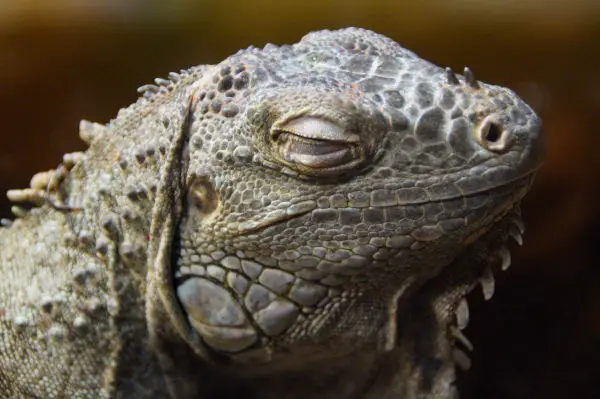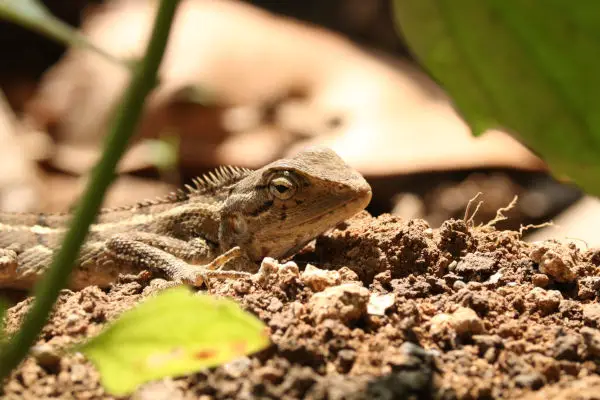Why Do Lizards Die On Their Backs? (Or is This Fake?)
If you have seen a lizard on its back you may have wondered why this happens and if there is a chance that it is really not dead…
Why Do Lizards Die on Their Backs?
When a lizard flips onto its back and appears dead, it’s playing off of its instincts to survive rather than actually dying. Like the opossum, when some species of lizard find themselves in a dangerous situation they’ll act dead until the threat moves on.
| Are these foods dangerous for your Beardie? | |
| Avacado? Click here to learn, from this guide, if this food is dangerous |  |
| Superworms? Click here to learn, from this guide, if this food is dangerous |  |
So, now you know. But, how can tonic immobility save a lizard? How do you know if it’s really dying or not? Why do they go belly up when they die? Keep reading to get these answers, and much more…
Do Lizards Fake Their Own Death?

An Iguana lizard closing its eyes.
Lizards do fake their own death. Many animals rely on instincts to survive and, when other attempts fail to get them out of danger, they simply fake their own death. In the case of the lizard, their first defense is the ability to lose their tail and regrow it later, called tail autonomy.
If that fails or they’re flipped onto their backs, they have the option to play dead by ceasing movement using tonic immobility to avoid actual death.
How Can Tonic Immobility Save a Lizard’s Life?
Tonic immobility saves lizards because so many predators hunt by movement or just lose interest when their prospective prey suddenly stops moving. Since this state of being can remain for minutes at a time depending on the situation, most predators will move on.
To clarify, Tonic immobility is a psychological state that lizards and other animals can go into to escape death by becoming completely unresponsive. Basically, they flip over and completely stop moving even when poked or prodded.
In some cases, animals will physically alter when entering tonic immobility to become unable to be eaten. With the lizard, it assumes a position that’s unnatural for a dead animal but the lack of movement is usually enough to save its life.
How Do You Bring a Dead Lizard Back to Life?
While tonic immobility is a false state of death, lizards tend to spend a lot of their time near water sources and have a habit of falling in now and then. If this happens, you have to shake them by their tail, perform CPR, or give them mouth-to-mouth to resuscitate them.
If holding them by their tail and shaking them doesn’t bring them back, be gentle with your CPR. Use your index fingers to locate their tiny ribcage and push in. The bad news is that, upon revival, lizards can be jumpy and go back into the water so be on alert.
How Do You Know if a Lizard is Dying?

A lizard lying down.
Depending on the cause of death, you may notice your lizard’s skin coloration lightening or becoming gray, a lack of motivation and movement, a lack of appetite, shorter breaths, or your lizard might be spending more time in the cold part of the tank.
There are several causes of death in lizards, such as old age. If your lizard sleeps more often, generally moves without purpose, and has a smaller appetite, these have all been traits attributed to aging.
It should be noted, though, that lethargy and disinterest are completely normal when your lizard is going through brumation or the lizard version of hibernating. These behaviors are only unusual during the rest of the year.
Do Lizards Die if They Fall From a Height?
Some lizards do die if they fall from a height. I say some because it depends on the lizard, the wind, and the distance. However, a lizard can survive a fall from a great height because of its tail and size.
Basically, lizards are capable of using their tail in mid-air to adjust their free-fall to flatten out. This creates more drag against gravity and reduces their falling speed, which is why a windy day could cause problems.
Add to this the fact that smaller lizards, like a gecko, wouldn’t reach terminal velocity and it’s entirely plausible for them to survive a fall, especially if they were to land on something soft. They’re not quite cat-like, but you wouldn’t be able to write them off.
Why Do Lizards Die?
Like most animals, they can die from old age, illness, or poor care. Outside of captivity, you’d also have to include predators in this list. Old age was covered previously with ways to tell your lizard is dying, but illness and care are very specific.
Lizards are high-maintenance when it comes to proper care because, while it’s simple, you have to be very exact with your temperature settings. Not only does the humidity level have to be precise, but your tank can’t be far in one direction or the other.
Too hot?
Too hot and your lizard could dry out and die, too cold and they’ll freeze to death. Given, each lizard is different and the best way to avoid an issue is to just research your particular lizard and talk to the vet.
Diseases & parasites
As far as illnesses go, lizards are susceptible to all kinds of diseases and parasites. Being the owner, you’ll probably become accustomed to your lizard’s habits so as soon as they start acting unusual it’s best to get them checked out as soon as possible.
Your lizard could also die from impaction, which is caused by ingesting something too large. This could be a bug that’s too big or simply something from inside the tank that makes it into your lizard’s mouth.
What to Do With a Dead Lizard?
How you dispose of your lizard’s body is entirely up to you, but the first step should be to remove the body from the tank if it wasn’t alone. Take the body to a vet and find out the cause of death, because other lizards in the tank could be afflicted with the same thing.
With that taken care of, you have the option to return it to where you got it from, throw it in the dumpster, or bury it in a small box. Many owners choose the latter since they become very attached to their pet, but again it’s your choice.
Why Do Animals Go Belly-Up When They Die?
The most common reason for animals to be belly-up upon death is either the lower center of gravity or whatever killed them left them in this state. For example, when a cat kills a cockroach it paws at the bug until it’s on its back.
When animals die their limbs go limp so an animal lower to the ground might simply turn over. In the lizard’s case, if a predator doesn’t fall for the tonic immobility, it’s already on its back when it dies.
How Can You Tell if Your Lizard is Sick?
Lethargy and loss of appetite were already mentioned earlier, but other symptoms that can indicate your lizard isn’t feeling good are a loss of weight, sunken eyes, and fewer droppings. Weight loss can be caused by a lack of appetite, but it’s a little tricky.
That’s because some lizards can go weeks or even months without eating, and it can take a long time for any amount of drastic weight loss to be obvious. It’s always best to get them checked out as soon as you suspect anything, just in case.
Don’t wait too long…
If you wait too long, the weight loss will cause their energy to deplete and whatever illness is affecting them will possibly take their life. A good counter to malnutrition is supplementing their diet, similar to the counter for sunken eyes.
Lizards are known for their large eyes and watery mouths, so if you notice that their eyes are sunken in or their skin isn’t shedding like it should it could be a sign of serious dehydration. The supplement in this case is a syringe of nutrient-boosted liquid.
You might also want to check the temperature settings in your tank because the dehydration was likely caused by the temperature or lighting.
Lastly, fewer droppings is probably in tandem with the loss of appetite, weight loss, or a combination of all three. If you notice one, take your lizard to the vet and find out what’s wrong before the condition worsens.